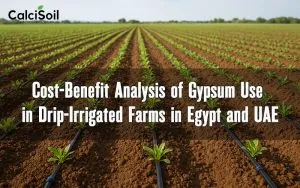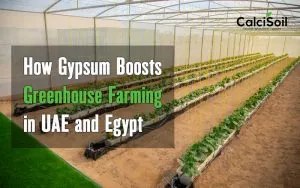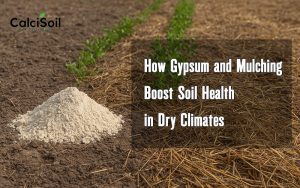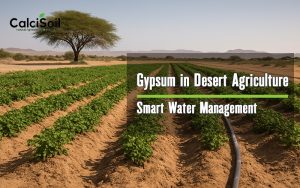
Gypsum and its impact on plant nutrition and crop yields
Gypsum (agricultural gypsum) is a mineral that has been used in agriculture for centuries. due to its ability to improve the soil structure and enhance the plant growth. Gypsum is a soft, sulfate mineral composed of the calcium sulfate dihydrate, with the chemical formula of CaSO4· 2H2O. It is widely available in the nature, and it can also be produced synthetically.
Improtance of using gypsum for plants
Gypsum is an essential nutrient for plants as it provides both calcium and sulfur. Calcium is vital for the plant growth and development. and it is a component of cell walls, making them stronger and more resistant to disease and pests. Sulfur is essential for formation of chlorophyll, the pigment that gives plants their green color and is essential for photosynthesis. Gypsum also helps to improve soil structure by reducing soil compaction, increasing water infiltration, and improving aeration.
Gypsum has been shown to have positive impact on the crop yields, particularly in areas with high levels of soil acidity. Soil acidity can limit plant growth by reducing nutrient availability and increasing toxicity of aluminum, which can cause root damage. Gypsum can neutralize soil acidity by replacing hydrogen ions with calcium ions, which are less likely to cause soil acidity. This can lead to increased nutrient availability, improved root growth, and higher crop yields.
Gypsum environmental benefits
In addition to benefits of gypsum for plant growth, gypsum has also been shown to have environmental benefits. Gypsum is a natural source of calcium and sulfur, which are essential nutrients for plant growth. By using gypsum, farmers can reduce the need for synthetic fertilizers. which can have negative environmental impacts such as eutrophication of waterways and greenhouse gas emissions. Gypsum also helps to reduce soil erosion by improving soil structure. which can prevent soil from washing away during heavy rainfall.
One study conducted in USA found that gypsum application increased corn yields by up to 26%in areas with acidic soils. The study also found that gypsum application led to an increase in soil organic matter and improved soil structure. Another study conducted in Pakistan found that gypsum application increased wheat yields by up to 16%in areas with saline soils. The study also found that gypsum application improved soil salinity and pH levels.
Gypsum application ways
Gypsum can be applied to the soil in several ways, including broadcasting, banding, and injection. Broadcasting involves spreading gypsum evenly over the soil surface. while banding involves applying gypsum in a concentrated band around the plant roots. Injection involves injecting gypsum directly into the soil using specialized equipment. The method of application will depend on the specific soil conditions and crop requirements.
It is important to note that while gypsum can have significant benefits for the plant growth and crop yields. it is not a panacea. Gypsum is most effective when used in combination with other soil amendments and fertilizers. Soil testing can help farmers determine the specific nutrient deficiencies and soil conditions on their farms. and develop a customized nutrient management plan.
In conclusion, gypsum is an essential nutrient for plant growth and crop yields. Its ability to improve soil structure and neutralize soil acidity makes it a valuable tool for farmers. who are looking to improve the health and productivity of their crops. Gypsum can also have environmental benefits by reducing the need for synthetic fertilizers and preventing soil erosion. While gypsum is not a magic solution, it can be an effective part of a comprehensive nutrient management plan for farmers. who are looking to improve their yields and sustainability.







